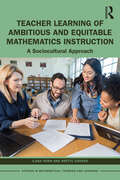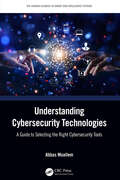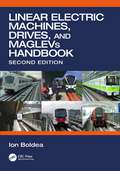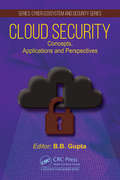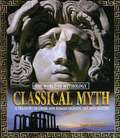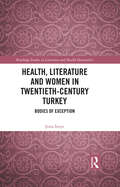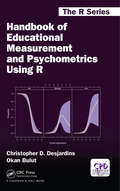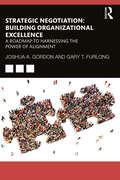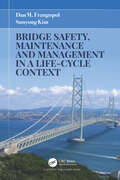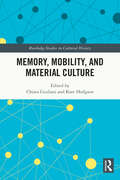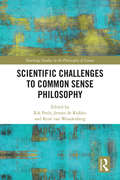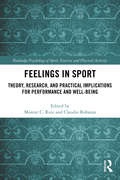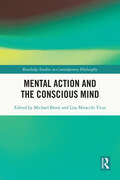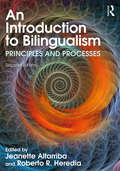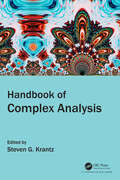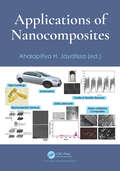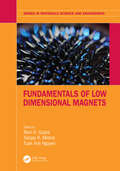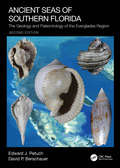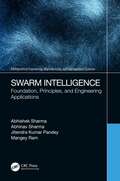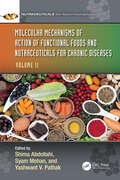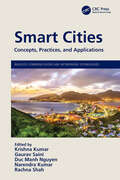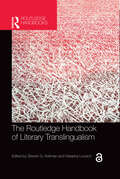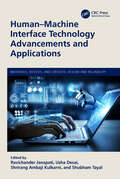- Table View
- List View
Teacher Learning of Ambitious and Equitable Mathematics Instruction: A Sociocultural Approach (Studies in Mathematical Thinking and Learning Series)
by Ilana Horn Brette GarnerDrawing on sociocultural learning theory, this book offers a groundbreaking theory of secondary mathematics teacher learning in schools, focusing on the transformation of instruction as a conceptual change project to achieve ambitious and equitable mathematics teaching.Despite decades of research showing the importance of ambitious and equitable teaching, few inroads have been made in most U.S. classrooms, and teacher learning in general remains undertheorized in most educational research. Illustrating their theory through closely documented case studies of secondary mathematics teachers’ learning and instructional practices, authors Horn and Garner explore the key conceptual issues teachers are required to work through in order to more fully realize ambitious and equitable teaching in their classrooms. By theorizing teacher learning from a sociocultural perspective and focusing on instructional practice, the authors make a unique contribution to the field of teacher learning.This book offers researchers, scholars, and teacher educators new theoretical and methodological tools for the elusive phenomenon of teacher learning, and provides instructional leaders and coaches with practical examples of how teachers shift their thinking and practice.
Understanding Cybersecurity Technologies: A Guide to Selecting the Right Cybersecurity Tools (The Human Element in Smart and Intelligent Systems)
by Abbas MoallemCyberattacks on enterprises, government institutions, and individuals are exponentially growing. At the same time, the number of companies, both small and large, offering all types of solutions has been increasing too. Since companies rely on technological solutions to protect themselves against cyberattacks, understanding and selecting the right solutions among those offered presents a significant challenge for professionals, company executives, and newcomers to the cybersecurity field.FEATURES Presents descriptions for each type of cybersecurity technology and their specifications Explains applications, usages, and offers case studies to enhance comprehension Offers an easy-to-understand classification of existing cybersecurity technologies Provides an understanding of the technologies without getting lost in technical details Focuses on existing technologies used in different solutions, without focusing on the companies that offer these technologies This book is intended to help all professionals new to cybersecurity, students, and experts to learn or educate their audiences on the foundations of the available solutions.
Linear Electric Machines, Drives, and MAGLEVs Handbook
by Ion BoldeaLinear motion is richly present in various industries, from direct electric propulsion in urban and interurban people movers on wheels or on magnetic “cushions” (MAGLEVs) to indoor transport of goods (conveyors, etc.), through plunger solenoids (to open hotel doors and as electromagnetic power switches), to compressor drives by linear oscillatory permanent magnet (PM) motors, smart phones integrated microphone and loudspeakers, and controlled vehicles’ suspension, etc. Besides the traditional rotary motor drives with mechanical transmissions, which mean friction limitations (weather dependent) in traction (heavy vehicles), more losses, positioning errors (backlash) in the process, and higher maintenance costs to handle them, linear motion in industry by direct electromagnetic forces is free of friction limitations for traction, free of mechanical transmission, and thus more efficient, with less maintenance cost and fewer positioning errors (backlash). This explains why they are used in so many applications already since the dramatic advancement of power electronics and digital control in the last four decades.Modeling, performance, design, control, and testing of linear electric machines (LEMs) show notable differences with respect to rotary electric motor drives, which warrant a dedicated treatment of these aspects.The Second Edition (First Edition: 2013) concentrates on the above technical aspects of various types of LEMs in close relationship with specific applications via numerical examples of modeling, design, control, and testing, with ample representative results from literature, industry and some of the author’s contributions, such as: Technical field and circuit modeling of linear induction motors in flat configurations for low and high speeds (with and without dynamic end effects) and in tubular configurations short travel design, control and testing Linear synchronous motor (LSM) drives in dc-excited, homopolar, reluctance and superconducting excitation configurations for urban and interurban high-speed vehicles propulsion and integrated propulsion and levitation (in MAGLEVs) modeling, design and control with full-scale numerical examples, with emphasis on lower KWh/passenger/Km at high speeds Flat and tubular linear permanent magnet (PM) synchronous motors (L-PMSMs), mainly destined to industrial indoor transport for automation at high efficiency in clean rooms Linear “flux-modulation” motors— new breed, suitable for very low-speed applications due to higher thrust density Plunger solenoids in various applications including new valve PM actuators with millisecond response time Linear resonant PM oscillatory motors design, control and testing mainly destined to compressors for higher efficiency in compact drives Attraction and repulsive force suspension (levitation) systems for MAGLEVs Active and passive guideway MAGLEVs in urban and superhigh-speed interurban transport at lower Kwh per passenger/km (in lighter vehicles without wheels) The numerous numerical design and control examples (with practical specifications) throughout the 23 chapters of the book allow the reader deep and fast access to a practical but thorough unitary (good for comparisons) methodology in designing and controlling LEMs for various applications.
Cloud Security: Concepts, Applications and Perspectives (Cyber Ecosystem and Security)
by Brij B GuptaCloud computing is an indispensable part of the modern Information and Communication Technology (ICT) systems. Cloud computing services have proven to be of significant importance, and promote quickly deployable and scalable IT solutions with reduced infrastructure costs. However, utilization of cloud also raises concerns such as security, privacy, latency, and governance, that keep it from turning into the predominant option for critical frameworks. As such, there is an urgent need to identify these concerns and to address them.Cloud Security: Concepts, Applications and Perspectives is a comprehensive work with substantial technical details for introducing the state-of-the-art research and development on various approaches for security and privacy of cloud services; novel attacks on cloud services; cloud forensics; novel defenses for cloud service attacks; and cloud security analysis. It discusses the present techniques and methodologies, and provides a wide range of examples and illustrations to effectively show the concepts, applications, and perspectives of security in cloud computing. This highly informative book will prepare readers to exercise better protection by understanding the motivation of attackers and to deal with them to mitigate the situation. In addition, it covers future research directions in the domain. This book is suitable for professionals in the field, researchers, students who are want to carry out research in the field of computer and cloud security, faculty members across universities, and software developers engaged in software development in the field.
Classical Myth: A Treasury of Greek and Roman Legends, Art, and History
by Jane BinghamThe World of Mythology series introduces the myths of the world's greatest civilizations. The Classical world of ancient Greece and Rome has had an immeasurable impact on Western culture, but what inspired some of the greatest writers, philosophers, and architects of all time? Gods were not only worshipped, but consulted for both minor problems and victory in battle. The legends of mortals Heracles and Perseus were wrapped up in the lives of the immortals. Art and artifacts, as well as photographs of the landscapes immortalized in the tales, bring the world of Classical myth to life.
Health, Literature and Women in Twentieth-Century Turkey: Bodies of Exception (Routledge Studies in Literature and Health Humanities)
by Şima İmşirHealth, Literature and Women in Twentieth-Century Turkey offers readers fresh insight into Turkish modernity and its discourse on health, what it excludes and how these potentialities manifest themselves in women’s fiction to shape the imagination of the period. Starting from the nineteenth century, health gradually became a focal topic in relation to the future of the empire, and later the Republic. Examining representations of health and illness in nationalist romances, melodramas and modernist works, this book will explore diseases such as syphilis, tuberculosis and cancer, and their representation in the literary imagination as a tool to discuss anxieties over cultural transformation. This book places Turkish literature in the field of health humanities and identifies the discourse on health as a key component in the making of the Turkish nation-building ideology. By focusing on the place of health and illness in canonical and non-canonised fiction, it opens a new field in Turkish literary studies.
Handbook of Educational Measurement and Psychometrics Using R (Chapman & Hall/CRC The R Series)
by Christopher D. Desjardins Okan BulutCurrently there are many introductory textbooks on educational measurement and psychometrics as well as R. However, there is no single book that covers important topics in measurement and psychometrics as well as their applications in R. The Handbook of Educational Measurement and Psychometrics Using R covers a variety of topics, including classical test theory; generalizability theory; the factor analytic approach in measurement; unidimensional, multidimensional, and explanatory item response modeling; test equating; visualizing measurement models; measurement invariance; and differential item functioning.This handbook is intended for undergraduate and graduate students, researchers, and practitioners as a complementary book to a theory-based introductory or advanced textbook in measurement. Practitioners and researchers who are familiar with the measurement models but need to refresh their memory and learn how to apply the measurement models in R, would find this handbook quite fulfilling. Students taking a course on measurement and psychometrics will find this handbook helpful in applying the methods they are learning in class. In addition, instructors teaching educational measurement and psychometrics will find our handbook as a useful supplement for their course.
Strategic Negotiation: A Roadmap to Harnessing The Power of Alignment
by Joshua Gordon Gary FurlongEmpowering organizations to thrive, this book provides a clear diagnostic framework with specific approaches and processes that leaders can use to build a negotiation function that will succeed each and every time.Negotiation is a required skill and a core competency, but most organizations focus exclusively on individual negotiation skills and abilities and pay little attention to the internal culture and environment that shapes and guides these individuals. This book takes a dramatically different approach to building success in each and every negotiation, producing results that align with organizational strategy at all levels.Professionals in sales, procurement and supply chain, human resources, change management, mergers and acquisitions, contracts, start-ups, construction partnering, and training consultants and students of business and law will value a text that understands how to build negotiation skills and capability across the organization by aligning individual skills with an evidence-based approach that actually works.
Bridge Safety, Maintenance and Management in a Life-Cycle Context
by Dan M. Frangopol Sunyong KimDuring the past two decades, it has been generally acknowledged that life-cycle bridge analysis can be a systematic tool to address efficient and effective bridge management under uncertainty life-cycle management at the bridge network level can lead to an improvement in the allocation of limited financial resources, ensuring the safety and functionality of the bridge network life-cycle management of bridges and bridge networks based on resilience and sustainability can improve their resistance and robustness to extreme events such as earthquakes, tsunamis, floods, and hurricanes bridge management should consider the impact of environmental conditions and climate change This book addresses important concepts and approaches developed recently on bridge safety, maintenance, and management in a life-cycle context. Bridge life-cycle performance and cost analysis, prediction, optimization, and decision making under uncertainty are discussed. The major topics include bridge safety and service life prediction; bridge inspection and structural health monitoring; bridge maintenance; life-cycle bridge and bridge network management; optimum life-cycle bridge management planning; resilience and sustainability of bridges and bridge networksunder hazards; and bridge management considering climate change. By providing practical applications of the presented concepts and approaches, this book can help students, researchers, practitioners, infrastructure owners and managers, and transportation officials to build up their knowledge of life-cycle bridge performance and cost management at bothproject level and network level under various deteriorating mechanisms, hazards and climate change effects.
Memory, Mobility, and Material Culture (Routledge Studies in Cultural History)
by Chiara Giuliani Kate HodgsonWith a focus on the object and where it is situated, in time (memory) and space (mobility), Memory, Mobility, and Material Culture embodies a multidisciplinary and cross-disciplinary approach.The chapters track the movement of the objects and their owner(s), within and between continents, countries, cities, and families. Objects have always been considered with an eye to their worth – economic, aesthetic, and/or functional. If that worth is diminished, their meaning and value disappear, they are just things. Yet things can still fulfil functions in our daily lives; they hold symbolic potential, from personal memory triggers, to focal points of public ritual and religion; from collectors’ obsession, to symbols of loss, displacement, and violence. By bringing into dialogue the work of specialists in ethnology, art history, architecture, and design; literature, languages, cultures, and heritage studies, this volume considers how displaced memory – the memory of refugees, migrants, and their descendants; of those who have moved from the countryside to the city; of those who have faced personal upheaval and profound social change; those who have been forced into exile or experienced major personal or collective loss – can become embodied in material culture. This book is important reading to those interested in cultural and social history and cultural studies.
Scientific Challenges to Common Sense Philosophy (Routledge Studies in the Philosophy of Science)
by Rik Peels; Jeroen de Ridder; René van WoudenbergCommon sense philosophy holds that widely and deeply held beliefs are justified in the absence of defeaters. While this tradition has always had its philosophical detractors who have defended various forms of skepticism or have sought to develop rival epistemological views, recent advances in several scientific disciplines claim to have debunked the reliability of the faculties that produce our common sense beliefs. At the same time, however, it seems reasonable that we cannot do without common sense beliefs entirely. Arguably, science and the scientific method are built on, and continue to depend on, common sense.This collection of essays debates the tenability of common sense in the face of recent challenges from the empirical sciences. It explores to what extent scientific considerations—rather than philosophical considerations—put pressure on common sense philosophy. The book is structured in a way that promotes dialogue between philosophers and scientists. Noah Lemos, one of the most influential contemporary advocates of the common sense tradition, begins with an overview of the nature and scope of common sense beliefs, and examines philosophical objections to common sense and its relationship to scientific beliefs. Then, the volume features essays by scientists and philosophers of science who discuss various proposed conflicts between commonsensical and scientific beliefs: the reality of space and time, about the nature of human beings, about free will and identity, about rationality, about morality, and about religious belief. Notable philosophers who embrace the common sense tradition respond to these essays to explore the connection between common sense philosophy and contemporary debates in evolutionary biology, neuroscience, physics, and psychology.
Feelings in Sport: Theory, Research, and Practical Implications for Performance and Well-being (Routledge Psychology of Sport, Exercise and Physical Activity)
by Montse Ruiz Claudio RobazzaFeeling states, including emotional experiences, are pervasive to human functioning. Feeling states deeply influence the individual’s effort, attention, decision making, memory, behavioural responses, and interpersonal interactions. The sporting environment offers an ideal setting for the development of research questions and applied interventions to improve the well-being and well-functioning of the people involved. This ground-breaking book is the first to offer cutting-edge knowledge about contemporary theoretical, methodological, and applied issues with the contributions of leading researchers and practitioners in the field. Feeling states in sports are comprehensively covered by adopting an international and multi-disciplinary perspective. Part I covers most relevant conceptual frameworks, including emotion-centred and action-centred approaches, challenge and threat evaluations, an evolutionary approach to emotions, and the role of passion in the experience of emotion. Part II focuses on interpersonal aspects related to emotions and regulation, encompassing social and interpersonal emotion influence and regulation, social identity and group-based emotions, and performance experiences in teams. Part III presents applied indications surrounding emotional intelligence training, and emotional regulation strategies including imagery, self-talk, the use of music, mindfulness, motor skills execution under pressure, self-regulation in endurance sports, and the use of technology. Finally, Part IV examines issues related to athlete well-being, including the role of emotions in sport injury, emotional eating, and mental recovery. Feelings in Sport: Theory, Research, and Practical Implications for Performance and Well-being is an essential source for sport psychology practitioners, researchers, sports coaches, undergraduate and postgraduate students.
Mental Action and the Conscious Mind (Routledge Studies in Contemporary Philosophy)
by Michael BrentMental action deserves a place among foundational topics in action theory and philosophy of mind. Recent accounts of human agency tend to overlook the role of conscious mental action in our daily lives, while contemporary accounts of the conscious mind often ignore the role of mental action and agency in shaping consciousness. This collection aims to establish the centrality of mental action for discussions of agency and mind. The thirteen original essays provide a wide-ranging vision of the various and nuanced philosophical issues at stake. Among the questions explored by the contributors are: Which aspects of our conscious mental lives are agential? Can mental action be reduced to and explained in terms of non-agential mental states, processes, or events? Must mental action be included among the ontological categories required for understanding and explaining the conscious mind more generally? Does mental action have implications for related topics, such as attention, self-knowledge, self-control, or the mind-body problem? By investigating the nature, scope, and explanation of mental action, the essays presented here aim to demonstrate the significance of conscious mental action for discussions of agency and mind. Mental Action and the Conscious Mind will be of interest to scholars and graduate students working in philosophy of mind, philosophy of action, and philosophy of agency, as well as to philosophically inclined cognitive scientists.
An Introduction to Bilingualism: Principles and Processes
by Jeanette Altarriba and Roberto R. HerediaThe study of bilingualism and all of its aspects – from theory and models to social approaches and their practical applications – forms the cornerstone of the 2nd edition of this work. The chapters cover the latest advancements in the domains of psycholinguistics, neuroscience, creativity, and executive functioning. Contributions, new to this edition, offer the reader the most up-to-date research on lifespan and developmental issues. The work also provides insight into how human language is processed by all, not just by bilingual and multilingual speakers.This text is ideal for senior undergraduate and graduate courses in psycholinguistics and the psychology of language, especially those with an emphasis on bilingualism or second language learning.
Handbook of Complex Analysis
by Steven G. KrantzIn spite of being nearly 500 years old, the subject of complex analysis is still today a vital and active part of mathematics. There are important applications in physics, engineering, and other aspects of technology. This Handbook presents contributed chapters by prominent mathematicians, including the new generation of researchers. More than a compilation of recent results, this book offers students an essential stepping-stone to gain an entry into the research life of complex analysis. Classes and seminars play a role in this process. More, though, is needed for further study. This Handbook will play that role. This book is also a reference and a source of inspiration for more seasoned mathematicians—both specialists in complex analysis and others who want to acquaint themselves with current modes of thought.The chapters in this volume are authored by leading experts and gifted expositors. They are carefully crafted presentations of diverse aspects of the field, formulated for a broad and diverse audience. This volume is a touchstone for current ideas in the broadly construed subject area of complex analysis. It should enrich the literature and point in some new directions.
Applications of Nanocomposites
by Ahalapitiya H. JayatissaIn this book, different applications of nanomaterials are described based on experiments, validations, and prototype manufacturing. It also covers synthesis, characterization, functionalization and coating of nanomaterials in various application-oriented investigations. The use of nanomaterials in energy storage, catalyst preparation and tribology are a few examples of improving the efficiency of future technologies. In addition, this book has also contributed to the nanomanufacturing of composites for automobile industries, glass industries, textiles and flexible electronics. This book provides knowledge on multiple related fields in applying nanomaterials, emphasizing the most updated literature, understanding applications, and consists of examples and illustrations so that readers can absorb the content rapidly.
Fundamentals of Low Dimensional Magnets (Series in Materials Science and Engineering)
by Ram K. Gupta Sanjay Mishra Tuan Anh NguyenA low-dimensional magnet is a key to the next generation of electronic devices. In some respects, low-dimensional magnets refer to nanomagnets (nanostructured magnets) or single-molecule magnets (molecular nanomagnets). They also include the group of magnetic nanoparticles, which have been widely used in biomedicine, technology, industries, and environmental remediation.Low-dimensional magnetic materials can be used effectively in the future in powerful computers (hard drives, magnetic random-access memory, ultra-low power consumption switches, etc.). The properties of these materials largely depend on the doping level, phase, defects, and morphology. This book covers various nanomagnets and magnetic materials. The basic concepts, various synthetic approaches, characterizations, and mathematical understanding of nanomaterials are provided. Some fundamental applications of 1D, 2D, and 3D materials are covered.This book provides the fundamentals of low-dimensional magnets along with synthesis, theories, structure-property relations, and applications of ferromagnetic nanomaterials. This book broadens our fundamental understanding of ferromagnetism and mechanisms for realization and advancement in devices with improved energy efficiency and high storage capacity.
Centering Whole-Child Development in Global Education Reform: International Perspectives on Agendas for Educational Equity and Quality
by Jaekyung Lee Kenneth K. WongThis volume offers critical analysis of national school reform policies intended to align with global agendas to promote educational quality and equity. By uniquely foregrounding the need for education reform to nurture child well-being alongside traditional measures of academic achievement, the book identifies common challenges across the Global North and South and extends insights provided by international student assessment data. Chapters offer a close analysis of reform practices in countries in Africa, Europe, Asia, and the Americas to consider cultural, social, political, and functional aspects which drive or inhibit the success of reform initiatives. Providing excellent insights into holistic education for children and youth, this book highlights lessons to support global efforts in providing high-quality, equitable education for the whole child. Developing international knowledge and supplementing international data, this volume will be of interest to students, scholars, and researchers with an interest in education policy, as well as comparative and international education.
Job Satisfaction: From Assessment to Intervention
by Paul E. SpectorDistilling the vast literature on this most frequently studied variable in organizational behavior, Paul E. Spector provides students and professionals with a pithy overview of the research and application of job satisfaction. In addition to discussing the nature of and techniques for assessing job satisfaction, this text summarizes the findings regarding how people feel toward work, including cultural and gender differences in job satisfaction, personal and organizational antecedents, potential consequences, and interventions to improve job satisfaction. Students, researchers, and practitioners will particularly appreciate the extensive list of references and the Job Satisfaction Survey included in the Appendix. This book includes the latest research and new topics including the business case for job satisfaction, customer service, disabled workers, leadership, mental health, organizational climate, virtual work, and work-family issues. Further, paulspector.com features an ongoing series of blog articles, links to assessments mentioned in the book, and other resources on job satisfaction to coincide with this text. This book is ideal for professionals, researchers, and undergraduate and graduate students in industrial and organizational psychology and organizational behavior, as well as in specialized courses on job attitudes or job satisfaction..
Ancient Seas of Southern Florida: The Geology and Paleontology of the Everglades Region
by Edward J. Petuch David P. BerschauerThe authors have done an outstanding job of compiling decades of data collected by their own field reconnaissance and other geoscientists… This represents a significant contribution to the understanding of the development of the Florida carbonate platform, and it will assist other disciplines as they strive for better understanding of our groundwater resources, aquifer characterizations, paleoenvironmental interpretations, and historical/educational geology programs.Walt Schmidt, Florida State Geologist & Chief, Florida Geological Survey, USA (praise for the first edition)Painting a complete picture of the history of the Everglades, Ancient Seas of Southern Florida: The Geology and Paleontology of the Everglades Region, Second Edition provides an overview of the geology, paleontology, and paleoceanography of the region. It emphasizes the upper 300m of the geologic framework of the area and gives insight into the local stratigraphy, geomorphology, lithology, and historical geology. Designed to be a field guide as well as a reference, the book is illustrated in full color with brand new photographs of exposed geologic sections, stratotype localities, collection sites, and details of interesting fossil beds.In this book, the authors illustrate almost 800 of the most important and diagnostic stratigraphic index fossils found in these beds, including over 50 species of corals and almost 700 species of mollusks, along with echinoderms, crustaceans, echinoids, petrified wood, and aquatic vertebrates. A new edition of The Geology of the Everglades and Adjacent Areas, it contains larger images of fossil shells, corals, and echinoderms and includes new updated geological data and concepts, as well as an expanded iconography of stratigraphic index fossils. Based on the data gleaned from these fossils, it also offers a series of geomorphological visualizations, showing the possible appearances of the Florida Peninsula during the times when it was covered by tropical seas, from the Oligocene to the late Pleistocene.This second edition provides a new perspective on both the historical geology of southern Florida and the evolution of one of America’s most beautiful natural treasures, the Everglades.
Swarm Intelligence: Foundation, Principles, and Engineering Applications (ISSN)
by Abhishek Sharma Abhinav Sharma Jitendra Kumar Pandey Mangey RamSwarm intelligence is one of the fastest growing subfields of artificial intelligence and soft computing. This field includes multiple optimization algorithms to solve NP-hard problems for which conventional methods are not effective. It inspires researchers in engineering sciences to learn theories from nature and incorporate them.Swarm Intelligence: Foundation, Principles, and Engineering Applications provides a comprehensive review of new swarm intelligence techniques and offers practical implementation of Particle Swarm Optimization (PSO) with MATLAB code. The book discusses the statistical analysis of swarm optimization techniques so that researchers can analyse their experiment design. It also includes algorithms in social sectors, oil and gas industries, and recent research findings of new optimization algorithms in the field of engineering describing the implementation in machine learning. This book is written for students of engineering, research scientists, and academicians involved in the engineering sciences.
Molecular Mechanisms of Action of Functional Foods and Nutraceuticals for Chronic Diseases: Volume II (Nutraceuticals)
by Shima Abdollahi Syam Mohan Yashwant V. PathakThere has been a global rise in the incidence of chronic illnesses, which may be partially attributed to the lengthening of the average human lifespan. Functional foods and nutraceuticals have a potential role to play in the development and maintenance of health. They can assist the body in its battle against inflammation and chronic illnesses.Molecular Mechanisms of Action of Functional Foods and Nutraceuticals for Chronic Diseases addresses the effects and mechanism of functional foods in relation to chronic diseases such as obesity, cardiovascular diseases, diabetes, cancer, etc. This volume, like the first volume Applications of Functional Foods and Nutraceuticals for Chronic Diseases, inspires new thought processes and a paradigm shift in research and development.Key Features: Discusses the molecular mechanism of action, the range of toxicities exerted by these food components for functional foods for addressing chronic conditions Enhances scientists and industrial personnel knowledge of functional foods and in the management of chronic diseases Presents research on the role of functional foods/nutraceuticals in preventing and treating chronic diseases through epigenetic modulation Explores various subjects such as epigenetics, immunological, metabolic, technological and neurodenerative aspects affected by functional foods in chronic diseases The world’s leading wellness centers for chronic diseases are using functional foods and nutraceuticals in their practice and discovering their useful applications, and this second of two volume set is another great reference for practitioners, scientists, and clinicians in the management of chronic diseases. Contributors hail from different geographical locations around the world and have many years of research and scholarly experience in functional foods, nutraceuticals, and biology.
Smart Cities: Concepts, Practices, and Applications (Wireless Communications and Networking Technologies)
by Krishna Kumar Gaurav Saini Duc Manh Nguyen Narendra Kumar Rachna ShahThis book discusses the various aspects of smart cities and their architecture along with the application of the latest technologies, including the Internet of Things (IoT) and artificial intelligence (AI). The concept of smart cities, their development, technological advancements, and issues related to them are discussed in detail.Smart Cities: Concepts, Practices, and Applications covers numerous topics, including energy utilities and the role of renewable energy for sustainable development, intelligent transport systems, traffic management, sewage and waste management, the impact of smart city development on the social and economic aspects of life, flexible communication technologies utilized in the development of smart cities, e-governance challenges, and implementation in smart cities.FEATURES Discusses the basic architecture of a smart city and its development concept Covers the application of IoT and AI in the development of smart cities Examines the impact of smart city development on social and economic aspects Presents comprehensively intelligent transport systems and traffic management This book will be useful for senior undergraduate and graduate students and professionals in electrical engineering, electronics and communication engineering, computer science, and civil engineering.
The Routledge Handbook of Literary Translingualism (Routledge Literature Handbooks)
by Steven G. KellmanThough it might seem as modern as Samuel Beckett, Joseph Conrad, and Vladimir Nabokov, translingual writing - texts by authors using more than one language or a language other than their primary one - has an ancient pedigree. The Routledge Handbook of Literary Translingualism aims to provide a comprehensive overview of translingual literature in a wide variety of languages throughout the world, from ancient to modern times.The volume includes sections on: translingual genres - with chapters on memoir, poetry, fiction, drama, and cinema ancient, medieval, and modern translingualism global perspectives - chapters overseeing European, African, and Asian languages Combining chapters from lead specialists in the field, this volume will be of interest to scholars, graduate students, and advanced undergraduates interested in investigating the vibrant area of translingual literature. Attracting scholars from a variety of disciplines, this interdisciplinary and pioneering Handbook will advance current scholarship of the permutations of languages among authors throughout time.
Human-Machine Interface Technology Advancements and Applications (Materials, Devices, and Circuits)
by Ravichander Janapati, Usha Desai, Shrirang Ambaji Kulkarni, and Shubham TayalHuman–Machine Interface Technology Advancements and Applications focuses on analysis, design, and evaluation perspectives in HMI technological breakthroughs and applications. It covers a wide range of ideas, methodologies, approaches, and instruments to give the reader a thorough understanding of the field's current academic and industry practice and debate. Physical, cognitive, social, and emotional factors are all considered in the work, which is exemplified by key application fields such as aerospace, automobile, medicine, and defense. This book covers AI and machine learning methodologies as well as biological signals and HMI applications. Nanotechnology, user interface design, and interactive systems are also featured. The MATLAB approach to signal processing applications is also included.This book discusses advances in the field of human–machine interfaces and provides practical knowledge in biomedical signal processing, AI, and machine learning. It discusses augmented reality/virtual reality-based HMI applications. It examines advances in nanotechnology, user interface design, and interactive systems.This book is intended to serve as a research guide that will both inform readers about the fundamentals of HMI from academic and industrial perspectives and provide a glimpse into how human-centered designers, such as engineers and human factors specialists, will attempt to design and develop human–machine systems in the future.
